Text
Proteles cristata
Throughout history, there have been two types of hyenas: bone-crushing hyenas, and dog-like ones. Spotted, striped, and brown hyenas are the bone-crushing type. Of the dog-like hyenas, the aardwolf is the only species left.

Aardwolf means "Earthwolf" in Afrikaans, a language spoken in Southern Africa. Their use of burrows is what earned them the "earth" part of their name. Although wolf is also in its name and it looks very dog-like, aardwolves are not canines. They are the smallest of four hyena species, weighing around 20 pounds (9.07 kg).
Unlike the other hyena species that eat carrion, aardwolves eat insects. If they really need to they can also eat eggs, small mammals, and vegetation, but insects are preferred. Their main insect prey is termites, and they can eat up to 300,000 of them in one night using their long tongues. Their tongues are very sticky as well, with large papillae (those little tongue bumps) and sticky saliva.
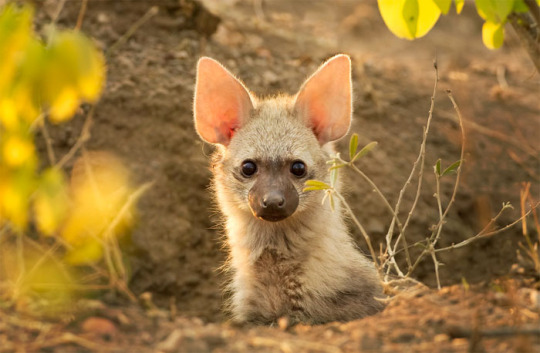
Since they behave differently and are much smaller than other hyena species, scientists used to think aardwolves were not part of the hyena family. With their striped coats, researchers thought they might have even been mimicking the striped hyena.
Aardwolves are found in arid plains of eastern and southern Africa, where they live in burrows dug by aardvarks, springhares, or porcupines. Some dig their own burrows, but taking over an abandoned one is much easier. They sleep in these burrows during the day, coming out at night to hunt for insects and to hang out with friends or whatever.
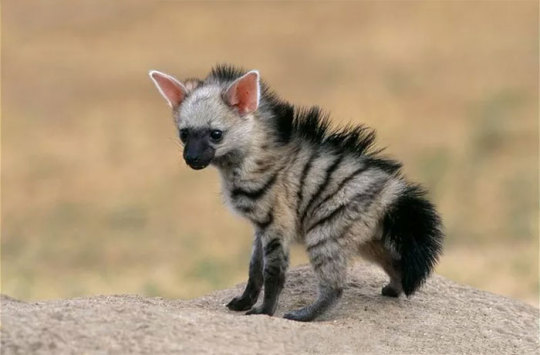

I rate the Aardwolf 15/10. Little cuties :,)

Photo Credits:
(1) Catherine Withers-Clarke (2) Hennie van Heerden (3) H. van den Berg (4) Scott Roberts (5) Klaus Rudloff
#aardwolf#CUTEEEEEEE#little guys#earthwolf#hyena#aardwolves#hyaena#biology#zoology#animals#science#nature#wildlife#african animals#cute animals#animals u should know about#miniature hyena
2K notes
·
View notes
Text
Parahyaena brunnea
Mostly due to habitat loss, brown hyenas are the rarest of the hyena species, with 4-10 thousand individuals in the wild. There are 30-50 thousand wild spotted hyenas, for comparison.
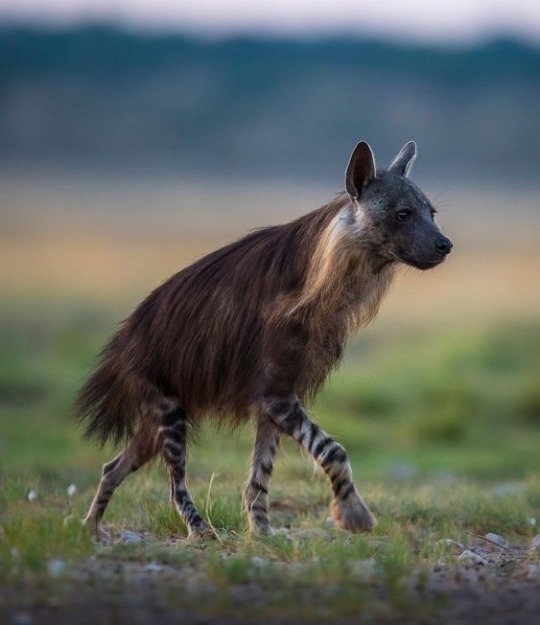
Brown hyenas are also known as strandwolves, which means "beach wolves" in Afrikaans, a language spoken primarily in South Africa. This name was given to them because brown hyenas in coastal areas spend a lot of time walking down beaches in search of food, and maybe to unwind after a long day. Some of the largest brown hyena populations are found in these coastal areas of Southern Africa, but there are also large populations in the Kalahari desert.

Although the name strandwolf suggests it, brown hyenas are not closely related to wolves or other canines. They can resemble canines, but hyenas are more closely related to cats than dogs. Their closest relatives are mongooses and civets. The photo below shows an African civet.
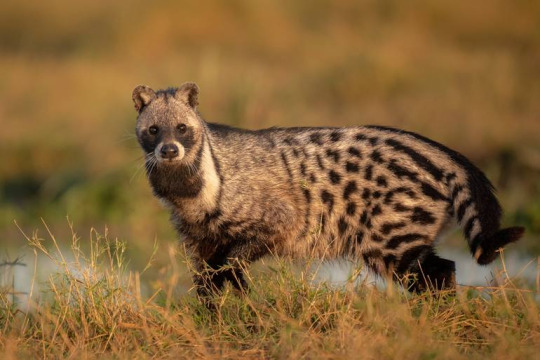
Brown hyenas are generally smaller than striped and spotted hyenas, but they can still get pretty big, weighing up to 90 pounds (40.8 kg). This size and their powerful jaws make them seem like formidable predators, but they're pretty bad hunters. They mostly scavenge for food or steal it from more capable hunters like cheetahs, leopards, and jackals. Since they can digest bones, hooves, horns, hair, and skin, they can basically eat every scrap food they find. Brown hyenas often live in groups, but this scavenging is done on their own.
Their clans are much smaller than those of spotted hyenas, and the structure is more similar to a wolf pack; most hyenas in the group are the offspring of the dominant hyenas. Brown hyenas are very social and form close bonds with other hyenas.
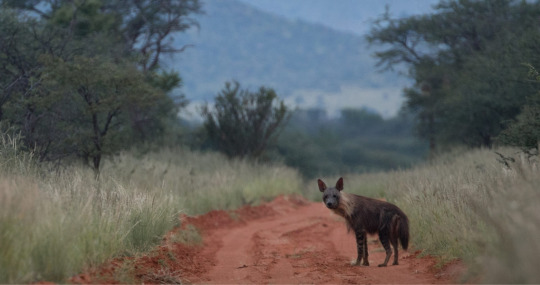
I rate the brown hyena 17/10. I like them. They seem a little bit lazy with their poor hunting skills and walks down the beach


Photo credits:
(1) Christophe Jobic (2) Mario Nonaka (3) Yarin Klien (4) Thilo Beck (5) Johan Swanepoel (6) Joel Sartore
#brown hyena#brown hyenas#hyena#hyenas#animals#biology#nature#science#wildlife#zoology#animal#wild#african animals#hyaena#south africa#Africa
428 notes
·
View notes
Text
Hyaena hyaena
Each of the four hyena species is in their own genus. This means that spotted hyenas, striped hyenas, brown hyenas, and aardwolves are not closely related and split from a common ancestor a super long time ago.
Striped and spotted hyenas split roughly 10 million years ago, which is around the same time that foxes split from wolves. So comparing a striped hyena to a spotted hyena is like comparing a red fox to a grey wolf-- both are in the same family, but they look and behave very differently because they diverged so long ago.
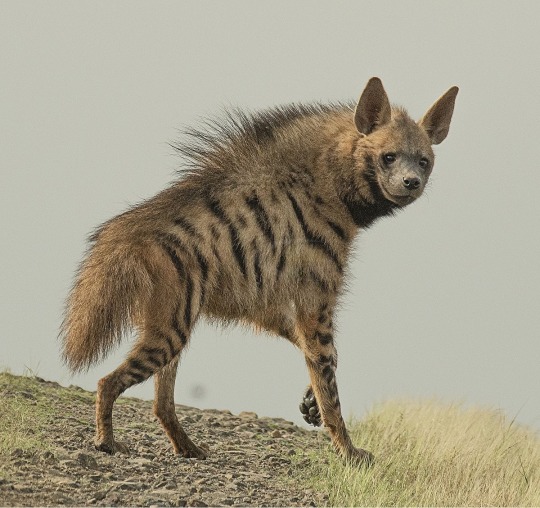
Striped and spotted hyena distributions overlap in East Africa, but the distribution of the striped hyena extends much further north, even into Central Asia. Striped hyenas in Asia are generally much larger than those in Africa, weighing from 50-90 pounds (22.7-40.8 kg).

Unlike spotted hyenas that frequently hunt live prey like wildebeest and antelope, striped hyenas depend almost entirely on scavenging. This means they eat plants, garbage, and especially carrion, but they avoid live prey.
Most hyenas have front legs that are longer and much stronger than their hind legs, and their necks are also very long and strong. The reason for this probably lies behind their scavenging behavior— with much stronger, taller legs and necks, hyenas can carry larger pieces of carrion more easily without it dragging through dirt or mud.
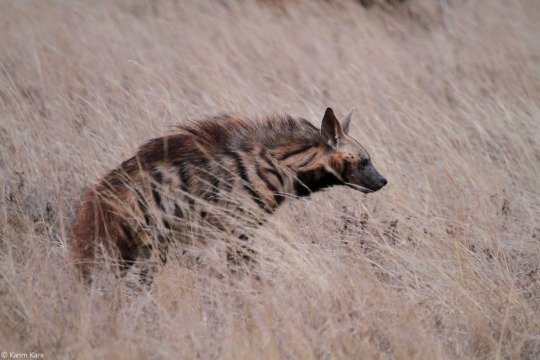
Although groups of up to 7 have been recorded, striped hyenas generally live alone or in pairs. This is very different from spotted hyenas, who live in clans that sometimes have over 100 individuals. Also unlike spotted hyenas, male striped hyenas actually help take care of their children.
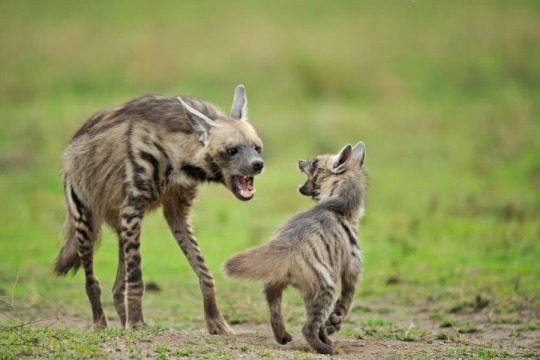
Striped hyenas mark their territories by producing strong-smelling, mushy stuff called "hyena butter" in their anal glands and smearing it on rocks, stumps, and other landmarks around their territory. You probably didn't want to know that, but now it's too late! Similar to a skunk, striped hyenas spray when they are attacked, as well as raising the mane-like hair on their neck and backs to appear much larger.
I rate striped hyenas 13/10. These things are something ELSE
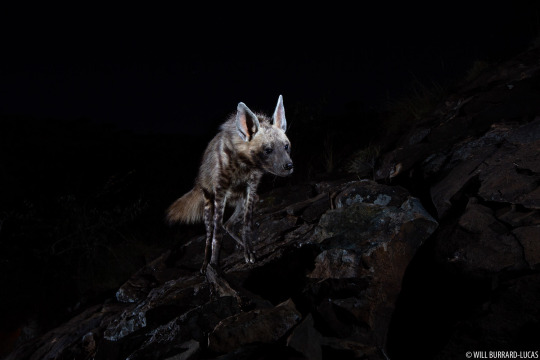
Photo credits:
(1) Rushikesh Deshmukh (2) Joel Sartore (3) Karim Kara (4) Africa Freak (5) Will Burrard-Lucas
#striped hyena dads are better than spotted hyena dads#hyena butter toast#hyena#hyaena#striped hyena#striped hyaena#animals#biology#nature#science#wildlife#zoology#animal#dogs#wild#weird animal#hyena butter
392 notes
·
View notes
Text
Crocuta crocuta
Although they have some dog-like traits, hyenas are only very distantly related to canines. They’re more closely related to cats. Their closest relatives, though, are actually mongooses (mongeese?) and civets.
Also known as laughing hyenas, spotted hyenas are the largest of four hyena species, weighing up to 140 pounds (63.5 kg)

Hyenas have a bad reputation. Although hyenas in some areas do kill livestock, this infamy is mostly due to myths and legends about them. They are believed to be “grave robbers,” or prone to digging bodies out of graves, as well as being stupid and cowardly. Spotted hyenas are even seen as demonic do to their wild laughing vocalization. The Lion King definitely didn’t help their case either, with spotted hyenas playing the role of dumb antagonists.
Another myth about hyenas is that they are hermaphrodites, meaning the species does not have distinct males and females. They do, but it’s almost impossible to tell them apart since both sexes have male genitalia. The females, which are more dominant than males, likely have male genitals due to high levels of testosterone.
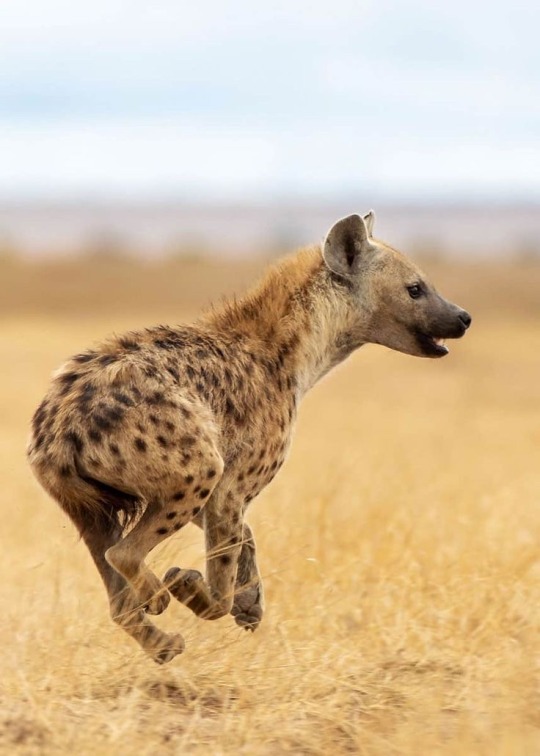
Hyenas are extremely social animals, forming close bonds and living in clans that can reach huge sizes, some with over 100 individuals. They are considered to be some of the most socially complex animals in the world and are highly cooperative with other hyenas, scoring higher than primates on tests that involve working with others.
This cooperative behavior is how they hunt (or steal). Large animals like wildebeest, zebra, antelope, and impala are targeted by groups of hyenas. Hyenas also get food by using large groups to steal prey from other predatory animals like lions, leopards, and African wild dogs. Every part of these stolen carcasses can be eaten, including the bones. This is thanks to extremely powerful jaws that give the hyena a bite force of 1100 PSI (almost as much as a grizzly bear).
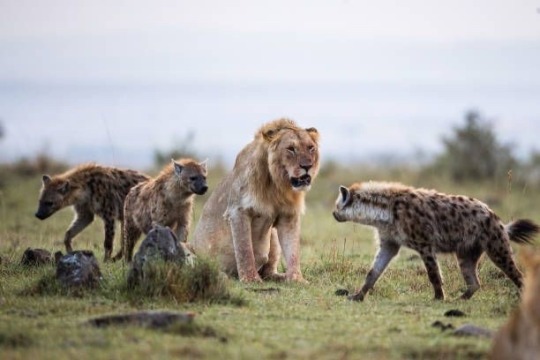
Hyenas also make some of the best parents in the animal kingdom. They have up to four cubs per litter, all of which are all born jet black, and they care for them for over a year. The mother also plays with them for hours at a time. They sometimes have to leave their cubs for long periods of time in order to hunt, but their extremely rich milk sustains the cubs through this time. Hyena milk is higher in protein and fat content than any other terrestrial carnivore.
I rate the spotted hyena 26/10 I love them so much I don’t even know what to say


Photo credits:
(1) Will Burrard-Lucas (2) Unknown (3) Kristian Sekulic (4) Carole Deschuymere (5) Keith Connelly
#i ran out of canines to write about so it’s hyena time#hyena#hyaena#hyenas#animals#biology#nature#science#wildlife#zoology#animal#wild#spotted hyena#spotted hyaena#spotted hyenas#african animals#crocuta crocuta
907 notes
·
View notes
Text
Canis lupus
Grey wolves are the largest canine species, usually weighing between 75 and 125 pounds (34 and 56.7 kg). The largest wolf ever recorded weighed 175 pounds (79 kg). This was a Mackenzie Valley wolf, and they are generally a lot larger than other grey wolf subspecies.

Although wolves in captivity have been observed with rigid roles in their packs like alpha, beta, “mid-rank”, and omega, this is not how it works in wild wolf packs. There are vague positions wolves have in a pack, but these are exaggerated in captivity when wolves are kept in close proximity to each other. Dispersal wolves, which are wolves who have left the pack they were born in, do sometimes join the packs of unrelated wolves, but wolf packs are usually just families. And in a family, of course the parents are going to be the most dominant. They are the “alpha” wolves. What people consider to be beta wolves would generally be older siblings- obviously less dominant than their parents but more dominant than siblings from newer litters. “Omega” wolves are believed to be extremely submissive, rejected, outcast wolves. It might appear to be like this in some cases, especially in captivity, but this role along with alpha and beta are clichés and rarely influence wild packs.
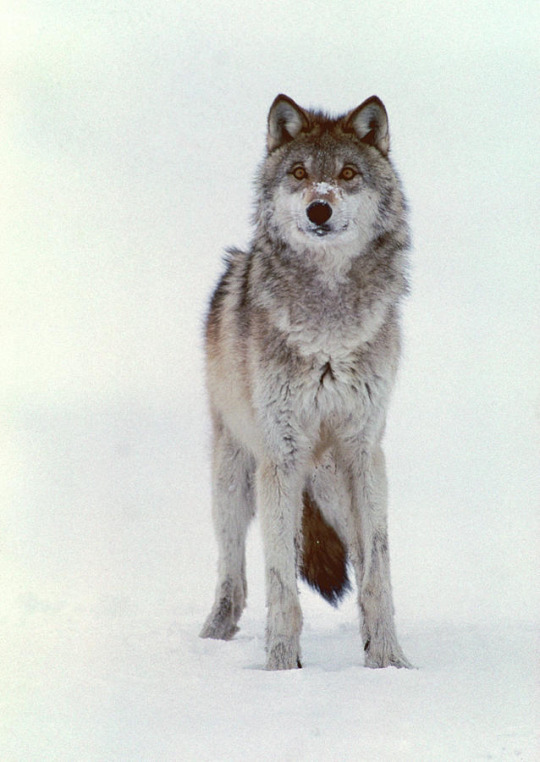
There is probably only one “true” wolf species in the world, and that’s the grey wolf. Many people believe that the Arctic wolf, timber wolf, or Eastern (Algonquin) wolf are different species, but they´re all subspecies of the grey wolf. Critically endangered red wolves are currently considered to be their own species, Canis rufus, but recent studies show that these wolves are likely the result of interbreeding between grey wolves and coyotes.
Domestic dogs are wolves too. They are considered to be a subspecies of the grey wolf just like Arctic and Eastern wolves are.

Just like red foxes aren't always red, grey wolves aren’t always grey. While the most common coat is agouti, which is a banded fur pattern consisting of grey, tan, black, and white, their coats can also have distinctive patterns or be solid colors. Wolves with mostly black fur are considered melanistic, which is sort of the opposite of albinism. They got this trait from domestic dogs that interbred with them centuries ago. Grey wolves very rarely come even close to being solid white, with the Arctic subspecies as an exception. Except for when they are young, since all wolves are born with brown fur, these Arctic wolves are almost always a solid white or cream color.

Found throughout much of North America, Europe, and Asia, grey wolves are second only to the red fox when it comes to distribution size among canines. In North America they generally hunt large prey like elk, moose, bison, and musk ox. In Europe and Asia they target musk deer, roe deer, and wild boar. Wolves in different regions or even individual packs specialize in hunting different prey. All wolves tend to hunt in a similar manner, running prey down using incredible stamina and sometimes chasing prey 30-40 miles (48.3-64.4 km) in a single day.

Many people believe that wolves howl at the moon. This is a cool idea, but it's a myth. Wolves do tend to howl with their faces pointed up towards the sky, but they only do that to help the sound carry farther. This way their howls can be heard up to 10 miles away. These howls are used to communicate with other wolves, sometimes to find members of their pack and other times to scare strange wolves away.
SUPER LONG POST OOPS
I rate the grey wolf 20/10. This is the animal ever


Photo credits:
(1) livingwithwolves.org (2) William Ervin (3) Jim Brandenburg (4) William Ervin (5) Michigan Technological University (6) Ross Forsyth (7) National Geographic
#super long post sorry I got really carried away#grey wolf#wolf#wolves#Canis lupus#my longest-standing hyperfixation#animals#biology#nature#science#wildlife#zoology#animal#dog#dogs#wild#timber wolf#arctic wolf#Algonquin wolf#canine#canines#wild dog
808 notes
·
View notes
Text
Canis latrans
Coyotes are very closely related to grey wolves and dogs. It’s believed that they split (or became a distinct species) from wolves around 1.5 million years ago. This is pretty recent compared to foxes that split over 9 million years ago.

The name coyote comes from “coyōtl,” which is the Aztec word for trickster. The coyote’s scientific name, Canis latrans, comes from the latin words for dog (Canis) and barking (latrans), so the name essentially means “barking dog.”

Coyotes are found throughout most of North America. They live all through Mexico and Central America, as well as most of Canada and every state except for Hawaii. They are found in a wide variety of habitats, including plains, mountains, deserts, forests, and urban areas.
Omnivorous like all other canines, the coyote’s diet changes in different regions. They are very adaptable and can live on mostly small animals, fruits, carrion, or garbage. They have been known to hunt larger animals like deer and bison calves, but this is harder for them than it is for wolves, their close relatives, due to their smaller size- Coyotes usually weigh around 30 pounds (13.6 kg) while wolves are generally over twice that size.

Similar to wolves, coyotes often live in packs, or family groups. These groups are usually smaller than wolf packs and they generally don’t hunt together. Although they prefer hunting alone like most other canines, coyotes have been recorded hunting with other animal species, specifically badgers. Badgers are very strong diggers, so coyotes work with them to hunt ground squirrels and prairie dogs.

To communicate with each other and define territories, coyotes howl. Their howls don’t sound like the classic wolf howl, though- theirs is very chaotic and shrill compared to a wolf’s, and it almost seems like they’re just screaming for fun.
I rate the coyote 14/10. Very chaotic energy

Photo credits:
(1) Rick (2) Milko Marchetti (3) Canid Camera (4) Jim Zuckerman (5) Unknown
#coyote#coyotes#dog#dogs#wild dog#wolf#wolves#canine#canines#canids#nature#animals#biology#science#wildlife#zoology#animal#wild
533 notes
·
View notes
Text
Canis dingo, or maybe Canis lupus dingo, or maybe Canis familiaris dingo
Some researchers think dingoes are an ancient breed of domesticated dogs brought to Australia around 4,000 years ago by Asian seafarers. Others think they are a distinct species closely related to grey wolves and domestic dogs, similar to coyotes and jackals.
Either way, dingoes are very closely related to wolves and domestic dogs and are able to interbreed with them. Most dingoes in Australia now are mixed with many different dog breeds. One of these dingo-dog hybrids is the Australian cattle dog, which is a pretty popular dog breed used for herding cattle.
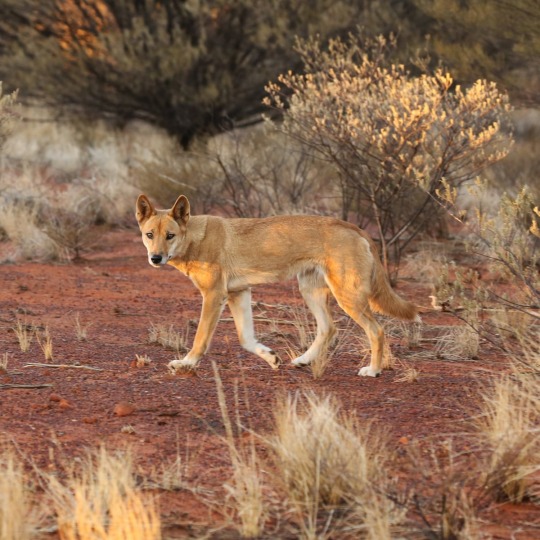
Dingoes are found in every state of Australia except for Tasmania. The dingo’s relative, the New Guinea singing dog, is also found in the mountains of New Guinea. Named for their unique yodeling howls, singing dogs are one of the most endangered canines in the world. They were believed to be extinct in the wild until a small population was found two years ago.

Those that live in the high Alpine habitats of southeast Australia are known as Alpine dingoes. They are often lighter in color and grow thicker coats than those that live in desert or forest habitats. Desert dingoes that live in northern Australia are the typical bright orange color. They are larger than other dingoes, generally weighing around 40 pounds (18 kg) with some reaching over 50 pounds (22.7 kg). There are dingoes that live in forests and have dark tan or black fur, but they are most likely not purebred.
Fraser Island off the east coast of Australia is home to around 200 dingoes. With no pet dogs on the Island, they are purebred. Fraser Island and Alpine dingoes are possibly the last populations that are not mixed with domestic dogs.
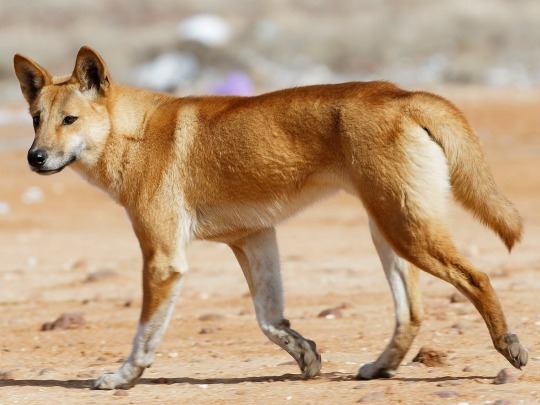
Often living in packs of up to 12 individuals, dingoes are very social. The dominant male and female of these packs are the parents of all the others. They rarely bark to communicate with each other, instead using a variety of howls.
In areas with small prey like hares, rodents, and reptiles, dingoes generally hunt alone. They still might live in packs, but they only rest and play with each other. In areas with larger prey like kangaroos and sheep, they hunt as a pack. Their tendency to hunt sheep causes farmers to target them, so the dingo population is classified by some as vulnerable but by others as endangered due to poisoning, trapping, and shooting.
Dingoes hunt by ganging up on larger prey with multiple pack members or by scaring small prey out of thickets and then pouncing. They are very flexible so they can follow prey into tight spaces. Like a cat, if a dingo’s head can fit through something, its whole body can.
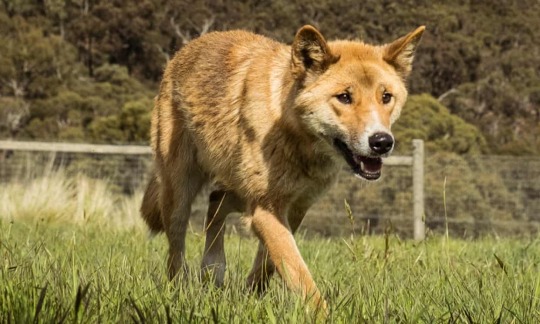
Wandi ^
I would also like to mention Wandi, who is a very good dingo. He was dropped by an eagle into a backyard when he was 5 weeks old. It was discovered soon after that he was a rare alpine dingo, so he went to live at the Dingo Discovery Sanctuary and Research Centre. He’s helping protect the species and he even has his own Instagram account.
I rate the dingo 17/10. A very Australian animal
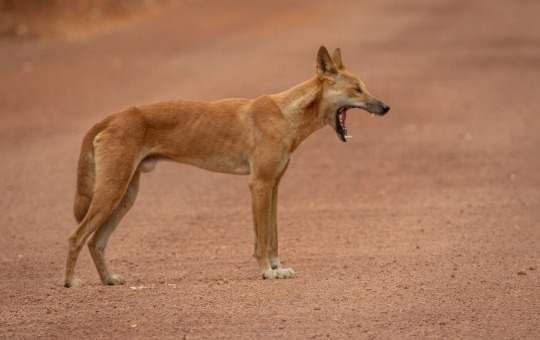
Photo credits:
(1) Jamie Lamb (2) Michelle J Photography (3) Michael Hains (4) Christopher Hopkins (5) tanyahattingh
#dingo#wild dog#Australia#animals#biology#nature#science#wildlife#zoology#animal#dog#dogs#wild#dingoes#wild dogs#canines#canids#canine#wolf#wolves
310 notes
·
View notes
Text
Canis anthus and Canis aureus
African golden wolves, Canis anthus, were believed to be an African subspecies of the Eurasian golden jackal, Canis aureus, until 2015 when genetic tests showed that they were more closely related to grey wolves. That makes them the first “new” canines to be discovered in 150 years.
Photos show golden jackals on the left and African golden wolves on the right
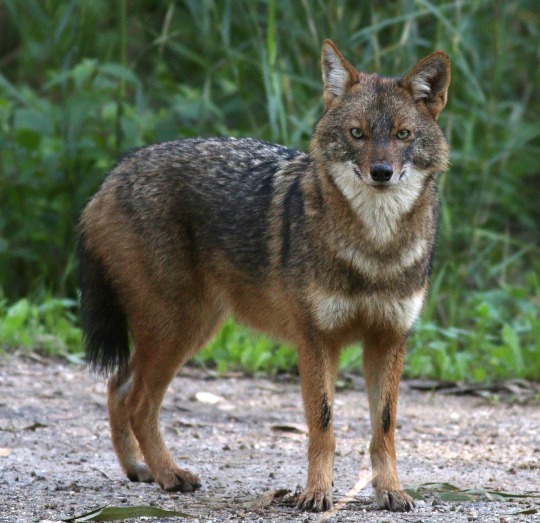
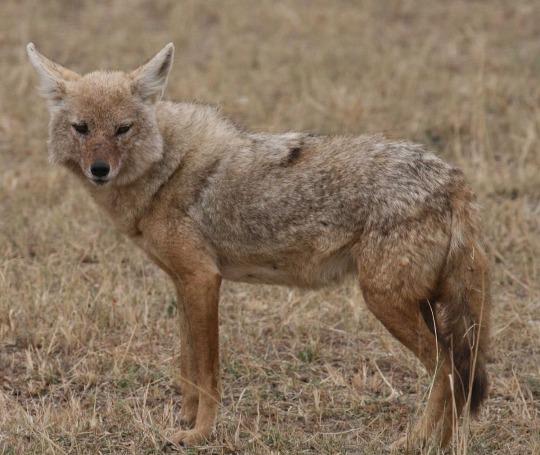
Golden jackals are widespread in Europe and Asia. They are most common in southern Eurasian countries ranging from Myanmar (Burma) to Greece, but they are spreading further into European countries. Within the past 20-30 years they have spread into Italy and Ukraine, and there was even a sighting of one in Norway last year.
African golden wolves, also known as African wolves or golden wolves, are found in all North African countries and some of West, Central, and East Africa. Generally found in grasslands, they also live in forests, savannas, and desert environments. Golden jackals are rarely found anywhere besides grasslands.

Golden jackal ^
Small animals including rodents, reptiles, birds, and insects make up roughly half of the golden jackal’s diet, the other half consisting of fruits and other vegetation. They are also known to follow tigers to scavenge off large animals they kill. Golden jackals are very social and do almost everything in pairs, including hunting and scavenge.
Golden jackals are good hunters due to an amazing sense of smell. Because of this, people bred them with huskies and spitz dog breeds to create the sulimov dog. Sulimov dogs have one of the strongest senses of smell of any dog breed and are used for this reason as sniffer dogs.
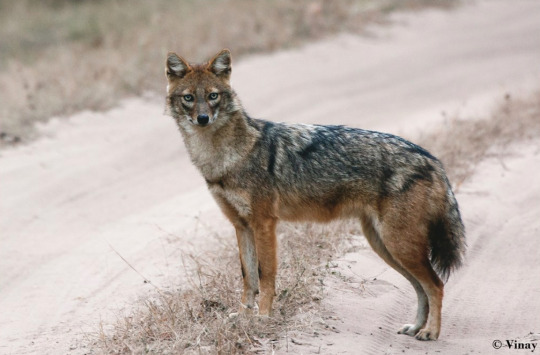
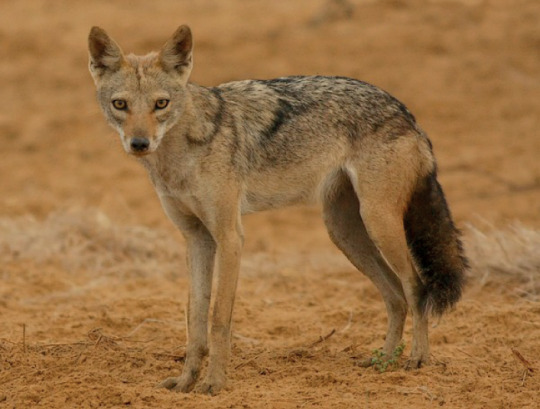
Wild boars make up most of the African wolf’s diet, but they also frequently hunt small animals like ground squirrels, hares, and insects like the golden jackal. Also like golden jackals, African wolves are pretty social. They rarely form large packs like grey wolves, who they are more closely related to than to golden jackals, but their adult offspring will often stay with the parents to help care for pups.
I rate the golden wolf and jackal 15/10. One hid as a jackal for many years and the other steals from tigers. Amazing

African wolf ^
Photo credits:
(1) Jan Ebr (2) Lee R. Berger (3) Carlo Galliani (4) Vinay Narayana Swamy (5) Cécile Bloch (6) Mourad-Harzallah
#jackal#wolf#golden jackal#golden wolf#african wolf#african golden wolf#wolves#jackals#animals#biology#nature#science#wildlife#zoology#animal#dog#dogs#wild
149 notes
·
View notes
Text
Lupulella adusta
Side-striped jackals are in the same genus as black-backed jackals, which means the species are closely related. Side-striped jackals are larger, averaging around 20 pounds (9 kg) but weighing up to 30 (13.6 kg). That’s 10 pounds more than the black-backed jackal.
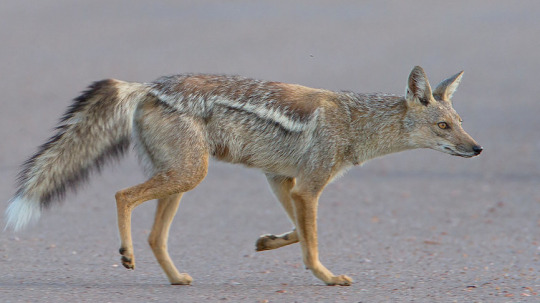
While black-backed jackals prefer dry savannas and forests in Southern and Eastern Africa, side-striped jackals generally live in wet flatlands, marshes, and mountains in Africa’s more tropical regions. This includes the Congo Basin as well as the countries of Mali, Nigeria, South Sudan, and others in a large band across Western, Central, and Eastern Africa. Their distribution is expanding into surrounding countries as well, which likely means their population is increasing.
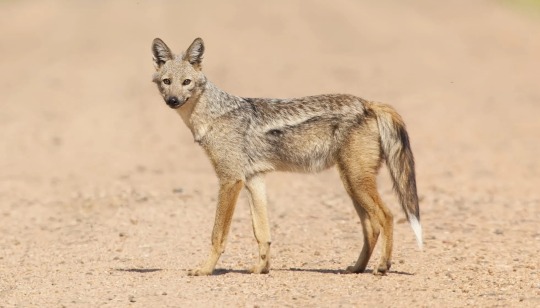
All jackal species are omnivores. This means they eat whatever is available, including fruit, carrion, birds, reptiles, insects, etc. Side-striped jackals have never been recorded hunting large prey, preferring carrion, plants, and small animals. They usually search for food at night and on their own or in pairs. These jackal pairs are very territorial, aggressively chasing off unrelated jackals and other predators like leopards and hyenas.
Jackals are quite social and often live in small family groups. Because of this they are very vocal, using a range of barks, howls, and yapping calls. Side-striped jackals are known to have a call that sounds like an owl hoot.
I rate side-striped jackals 14/10. Their white stripes are very unique
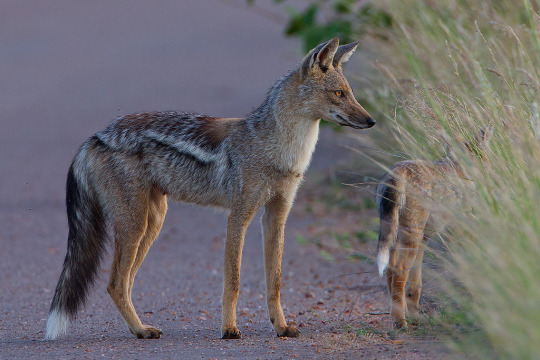
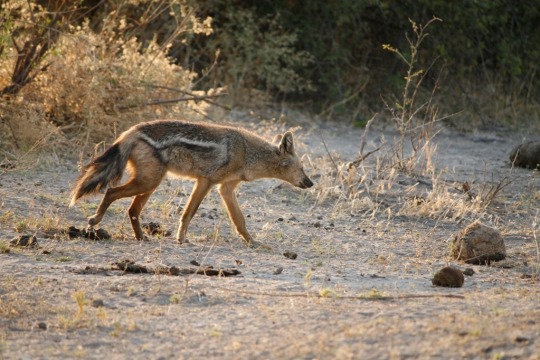

Photo credits:
(1) Dave Brown (2) Chris Fourie (3) Leon Molenaar (4) greatplainsconservation.com (5) Scotch Macaskill
#jackal#jackals#side striped jackal#side-striped jackal#african animals#animals#biology#nature#science#wildlife#zoology#animal#dog#dogs#wild#canine#canines#side striped jackals#side-striped jackals
162 notes
·
View notes
Text
Lupulella mesomelas
Until recently, jackals were in the Canis genus with wolves and coyotes. They are now in their own genus called lupulella, which consists of only two species- the side-striped jackal and the black-backed jackal. Golden jackals aren’t included in this genus because recent studies have shown that they are more closely related to grey wolves than to other jackal species.

The smallest jackal species is the black-backed jackal, found in Southern and Eastern Africa. They weigh roughly 13 to 20 pounds (5.8 to 9 kg) and are named after their distinctive “saddles,” or dark-colored bands on their backs.
Black-backed jackals are quite social. Most of them do almost everything in pairs, including hunting, digging dens, and raising pups, and they often form small family groups or packs. Because they are often hunted by leopards, eagles, and especially hyenas, which are much larger than them, groups of jackals are often more successful in raising pups and guarding their food.

Jackals usually target small animals like lizards, rodents, and hares, but groups of jackals will target impala, wildebeest calves, and other larger prey. They also eat insects and vegetation like plums and figs.
Although they are regularly hunted for their fur and by farmers and ranchers protecting livestock, black-backed jackals are classified as least concern. This means they are quite common and are not in danger of extinction.
I rate the black-backed jackal 12/10. Their ears are the perfect size
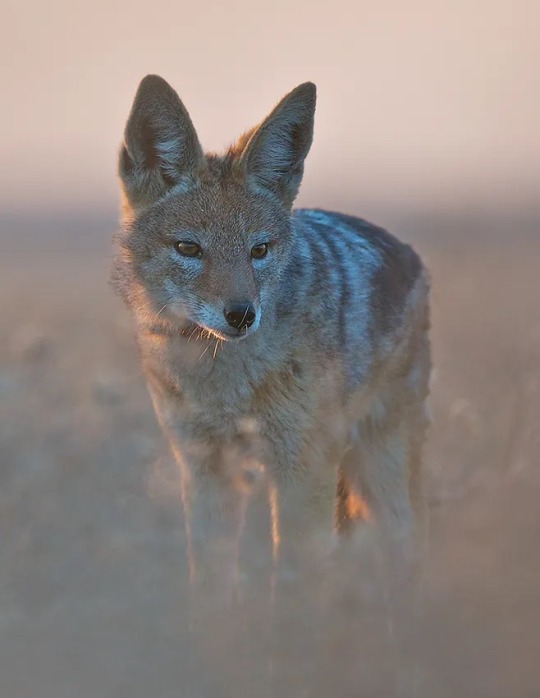
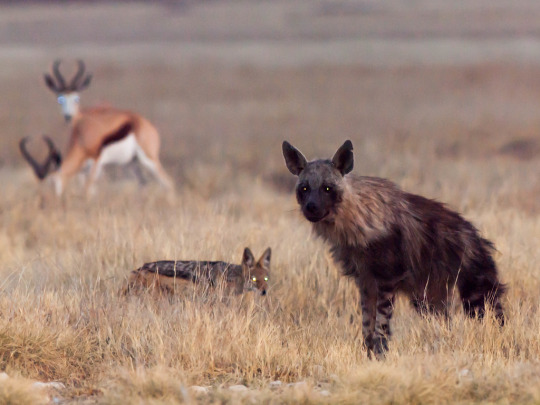
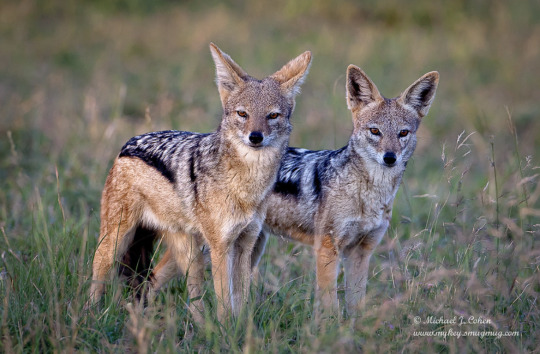
Photo credits:
(1) Thomas Reich (2) Sean Crane (3) Sean Crane (4) Chris Hartzell (5) Michael Cohen
#jackal#jackals#black backed jackal#black-backed jackal#canine#canines#animals#biology#nature#science#wildlife#zoology#animal#dog#dogs#wild#african animals
526 notes
·
View notes
Text
Atelocynus microtis
This odd-looking canine is called a short-eared dog. They are so elusive, though, that they are often called “ghost dogs.” Sightings of them are very rare, which makes research on them difficult.

There’s been a lot of confusion over what the short-eared dog is. It used to be in the lycalopex genus with the zorros and the cerdocyon genus with the crab-eating fox, but now it’s in its own genus- atelocynus.
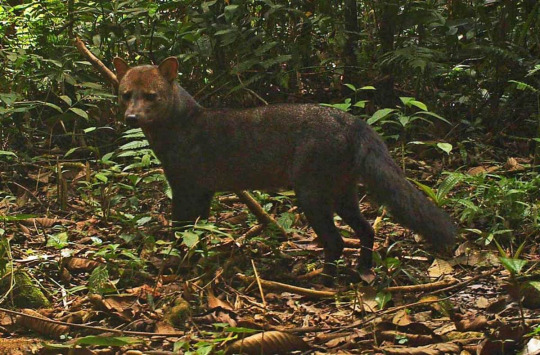
Short-eared dogs live in the Amazon rainforest in Peru, Columbia, Ecuador, Bolivia, and Brazil. They try to live far away from people, making them highly susceptible to habitat loss. Because of this it is suspected that their population is decreasing, but because sightings of them have always been rare it’s hard to estimate how many are left.
Studies of short-eared dog scat suggests that they eat lots of fruit, rodents, and fish. The fish in their diets along with their partially webbed feet could mean that short-eared dogs spend a lot of time in water, similar to the bush dog.
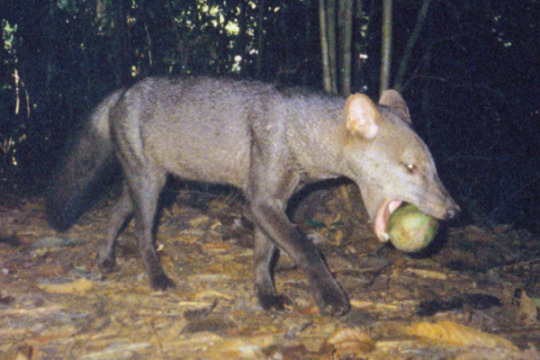
Much of what is known about these elusive animals comes from one short-eared dog named Oso, who was found when he was a puppy by a logger. He was then raised with pet dogs until a wildlife veterinarian named Renata Leite Pitman took over his care. By observing how Oso found food and interacted with other animals, Pitman learned about parts of the short-eared dogs’ life that scientists previously knew almost nothing about.
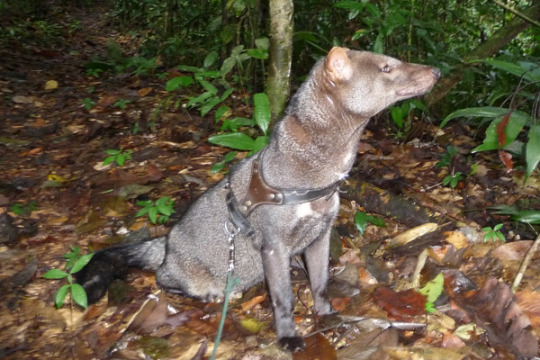
Before Pitman’s work with Oso, virtually nothing was known about short-eared dog vocalization, or the sounds they make. The veterinarian observed that Oso was very quiet but whined or “roared” when he was uncomfortable, and he occasionally made an unusual call that was “similar to some species of owl calls.”
When Oso was around 4 years old he was released into the wild with a tracker, allowing researchers to continue to learn about short-eared dogs.
I rate these very mysterious ghost dogs 13/10. They have a very distinctive look.

Photo credits:
(1) Galo Zapata-Rios (2) Owlcation (3) Renata Leite Pitman (4) Renata Leite Pitman (5) eMammal
#short eared dog#animals#biology#nature#science#wildlife#zoology#animal#dog#dogs#wild#canines#ghost dog#South American animals#South America#rainforest
2K notes
·
View notes
Text
Lycalopex fulvipes
Charles Darwin found these foxes on the voyage of the Beagle, so they were named after him. Their native name is zorro chilote.
They are described as charismatic and bold around people. After meeting one of them on Chiloé island in 1834, Darwin described them as “more curious or more scientific, but less wise, than the generality of his brethren”. In other words, Darwin’s foxes are very curious and observant, but not as wise as other fox species.

Darwin’s foxes are not actually foxes. True foxes belong to the vulpes genus, and these foxes belong to the lycalopex genus. They share this genus with the Sechuran fox, the hoary fox, the pampas fox, the culpeo, and the chilla. It was believed for a long time that the Darwin’s fox was a subspecies of the chilla, but they are now classified as a different species.
While most South American fox species prefer open grassland or scrub areas, Darwin’s foxes prefer dense forests. They are endemic to Chile, meaning they are only found there, with most individuals found on Chiloé island and in the Valdivian Coastal Range.
In these forests, Darwin’s foxes hunt for small animals like rodents and lizards along with fruit, eggs, beetles, and carrion. They are not strictly nocturnal, diurnal, or crepuscular, so they just hunt when they want to.
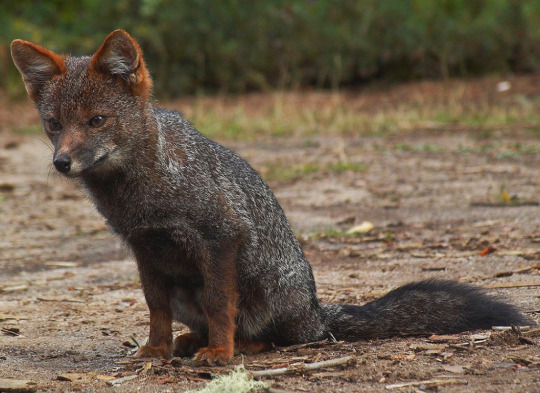
Like almost all other fox species, Darwin’s foxes prefer to live alone, only living in pairs during the breeding season and when they have kits.
Due to habitat loss, feral dogs, and being hunted for their fur, Darwin’s foxes are highly endangered with less than 1,000 individuals left. Conservation efforts have grown their population by small amounts but they are still in danger of extinction.
I rate this very curious fox 18/10. They may be “less wise” than other foxes but their charisma makes up for that
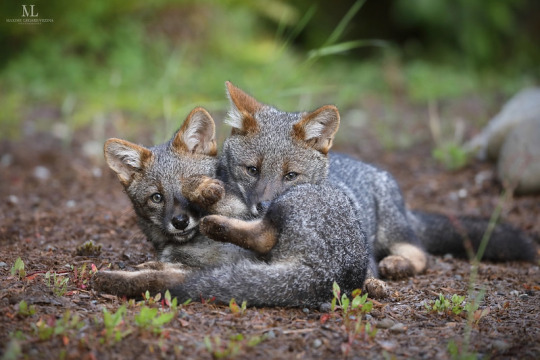
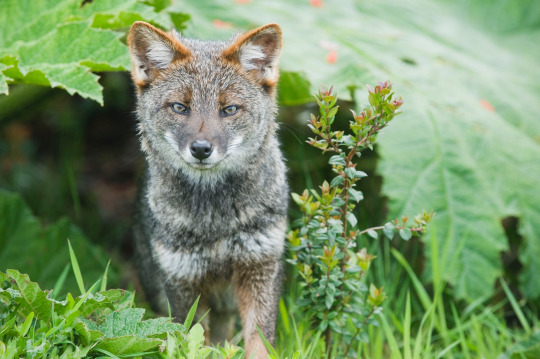
Photo credits:
(1) Jono Dashper (2) Unknown (3) Maxime Legare-Vezina (4) Kevin Schafer
#Darwin’s fox#animals#biology#nature#science#wildlife#zoology#animal#dog#dogs#wild#zorro#fox#foxes#darwin#charles darwin#chilote#zorro chilote
368 notes
·
View notes
Text
Lycalopex griseus
Also known as South American gray foxes or gray zorros, chillas are a species of false fox. This means they are called foxes but aren’t actually foxes; they are more closely related to coyotes, wolves, and jackals.
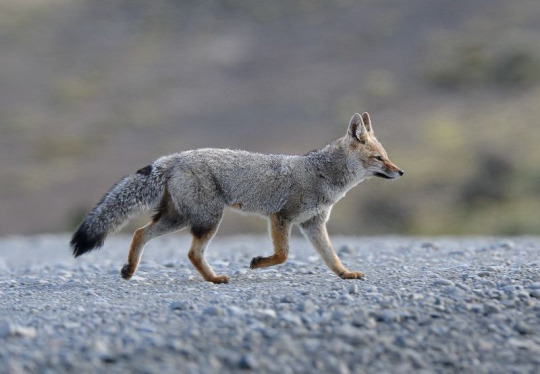
Chillas are found in Argentina and Chile where they live in rocky areas in the Andean Mountains as well as in grasslands and scrub. Chillas are classified as least concern, meaning they’re not in danger of extinction, although they are rare in some places because they are hunted for their fur.

Like most other fox species, chillas are omnivores. While most of their diet consists of small mammals, they also eat carrion, birds, eggs, and fruit. Since chillas mostly eat small mammals and many small mammals are most active at night, chillas are often nocturnal. Some populations of chillas are more active during the day (diurnal) or at dawn and dusk (crepuscular). Usually this is the case when they eat fewer small mammals and more fruit or birds.
Also similar to other fox species, chillas are very solitary animals. They usually only socialize with other foxes during the breeding season and when they have litters of kits. These litters are very small, usually consisting of only 2-4 kits.
I rate the chilla 10/10. It’s like a mini coyote


Photo credits:
(1) Daniele Colombo (2) Antony King Photography (3) Unknown (4) Daniel Sziklai G.
#chilla#South American grey fox#zorro#animals#biology#nature#science#wildlife#zoology#animal#dog#dogs#wild#foxes#fox#chilla fox#south American foxes
510 notes
·
View notes
Note
This is such a cool blog I love it! Pretty much an instant follow. Do you happen to know which is the biggest of the foxes (in height or weight)?
Thank you!! Red foxes are the largest in both height and weight, at least in the true foxes.
4 notes
·
View notes
Text
Lycalopex culpaeus
South American foxes, also know as zorros, aren’t really foxes- they are more closely related to wolves, coyotes and jackals. The culpeo is the largest South American fox species, weighing from 12 to 30 pounds (5-13.5 kg).

Culpeos are essentially the coyotes of South America. They are highly adaptable animals and live in a variety of habitats in western South America. These habitats include mountains, coastal beaches, plains, and deserts. Their distribution extends all the way from Ecuador and Peru to southern Patagonia.
Since most of their prey is active at night the culpeo is primarily nocturnal, although some populations are more active during the day (diurnal) or at dusk and dawn (crepuscular). Their diet consists mostly of rodents and rabbits but they also prey on lizards, birds, plants, carrion, and occasionally sheep, which makes them a target for shepherds.


Culpeos are very solitary animals, only seen in pairs during the breeding season and when they have pups. Even though they are very solitary and attack sheep, people attempted to domesticate them. This attempt didn’t go very well and the result, called a Fuegian dog or Yaghan dog, was only around until the early 1900′s. The dogs were used for hunting otters but they were apparently not loyal to their owners and frequently attacked livestock.
I rate the culpeo 14/10. They may have been bad dogs but they are very good foxes

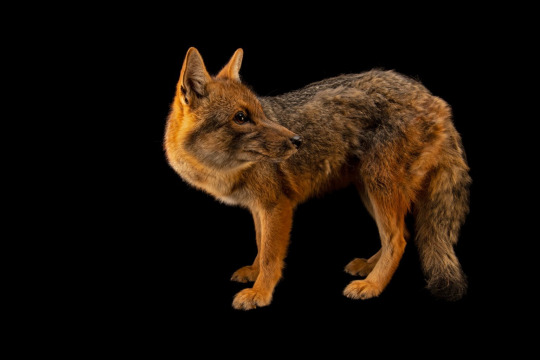
Photo credits:
(1) Torsten Klein (2) Bernardo Segura (3) doglime.com (4) Thomas Fuhrmann (5) Joel Sartore
#culpeo#culpeo fox#fox#animals#biology#nature#science#wildlife#zoology#animal#dog#dogs#wild#South American fox#zorro
281 notes
·
View notes
Text
Lycalopex gymnocercus
Pampas foxes are a medium sized fox species, weighing from 8.8 - 13.2 pounds (4 - 6 Kgs). They have a unique ability to play dead when threatened.

Because they aren’t in the vulpes genus, Pampas foxes aren’t actually foxes. Like the hoary fox, Sechuran fox, and three other fox species in their lycalopex genus, they are more closely related to jackals and coyotes than they are to true foxes.
These foxes are named after the Pampas, which are large, fertile grasslands in South America. These grasslands cover 460,000 square miles (1,200,000 sq km) in Argentina, Uruguay, and a very small part of southern Brazil. The Pampas fox lives all throughout this region as well as other grassland regions in central South America.

Like most fox species, Pampas foxes are omnivores. This means they eat both animals and plants, although they prefer eating meat. They’ll eat birds, rodents, armadillos, hares, invertebrates, and other small animals along with fruit, carrion, and eggs. And if they live around people, they also enjoy eating garbage.
Pampas foxes are very solitary, but they can be found in pairs during the breeding season and when they have kits. Both parents care for the litters which consist of up to eight kits. These kits are raised in dens which are often dug by other animals like armadillos.
I rate the Pampas fox 18/10. These dramatic dogs earn a very high rating from their habit of pretending to die instead of running from a threat.


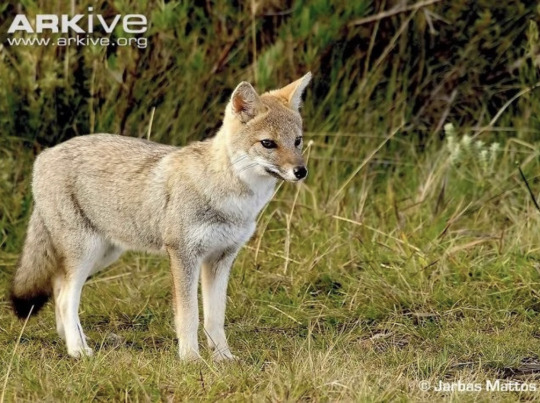
Photo Credits:
(1) Pablo Fraire (2) Agustinzar, Creative Commons (3) Wolf Education and Research Center (4) Unknown (5) Jarbas Mattos
#pampas fox#South American fox#zorro#animals#biology#nature#science#wildlife#zoology#animal#dog#dogs#wild#foxblr
60 notes
·
View notes
Text
Lycalopex vetulus
The hoary fox is part of the lycalopex genus, meaning they aren’t real foxes and are more closely related to coyotes and jackals. They share the lycalopex genus with the sechuran fox from the previous post and four other “false” foxes.

Hoary foxes are endemic to Brazil. This means they are native to Brazil and they aren’t found anywhere else. They are specifically native to the Cerrado of Brazil, which is a huge tropical savanna.
These foxes get their name from the color hoary, which is grayish-white like the foxes’ fur. In Brazil they are called raposinha-do-campo, which is Portuguese for “meadow fox.”
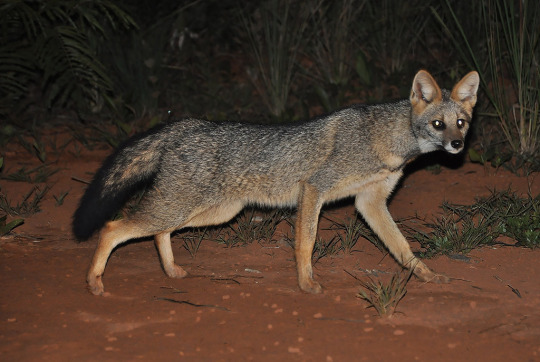
Weighing from 6 to 9 pounds (3 to 4 kg), hoary foxes are roughly the same size as a house cat. The foxes’ slender build allow them to be very agile and fast, making them efficient hunters. They are omnivores, hunting small rodents, birds, and reptiles, although most of their diet consists of fruit and insects.
Like the Sechuran fox, hoary foxes are solitary until the breeding season and when they have kits. They have very small litters that they raise in a den. Usually this den is taken over from an animal like an armadillo.
I rate the hoary fox 14/10. They have cool tails and their ears are the perfect fit for them
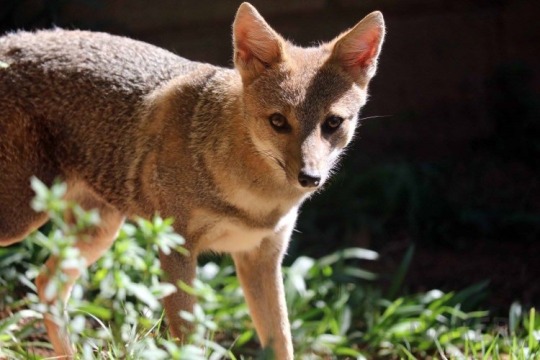

Photo credits:
(1) Unknown (2) Arthur Anker (3) Nayer Youakim (4) Joel Sartore
#hoary fox#fox#animals#biology#nature#science#wildlife#zoology#animal#dog#dogs#wild#foxes#hoary foxes#South American fox#zorro
316 notes
·
View notes